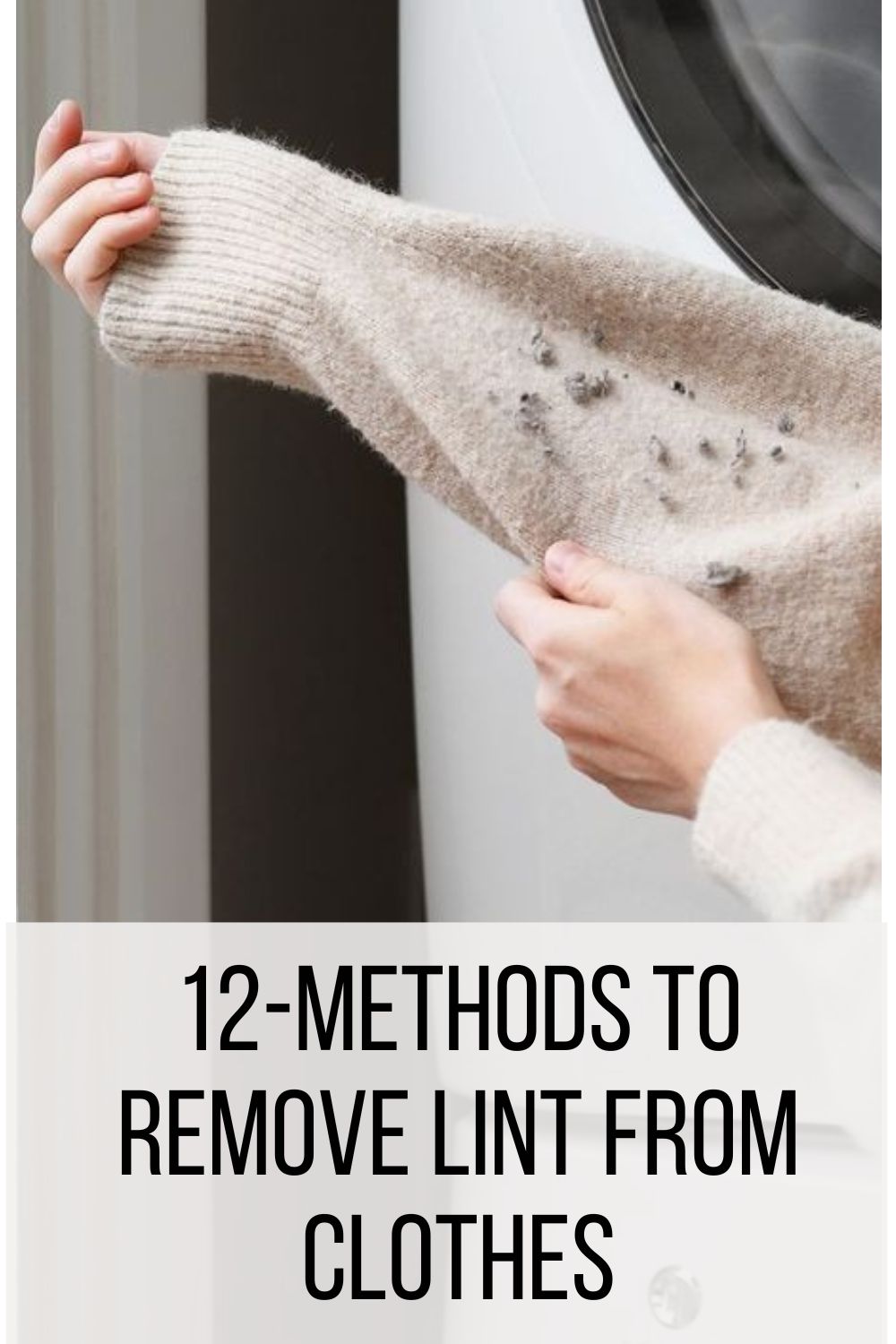
Is your outfit covered in lint? Are you frustrated by those tiny fuzz balls on your otherwise perfect sweater? Well, don’t worry because this is just the right place for you!
In this post, we will talk about lint on clothes in great detail. From what causes lint to how to get rid of it, read on to find your best solution!
Table of Contents
What is Lint?
Lint refers to the tiny fibers that come loose from the fabric and create white specks. When a lot of lint forms, a static cling collects it into small balls. This makes the fabric surface uneven, thin, and rough.
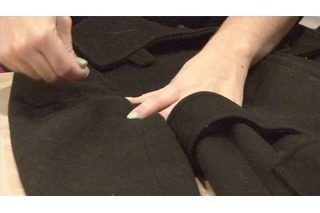
With that said, lint is only formed in fabrics that have weak, natural fibers. These include wool, polyester, cotton, and linen.
Regular wear and tear cause the fibers to break apart. When washing the clothes in the machine, the pressure of water further damages the fibers and pulls them out. This results in those white specks and tiny fuzz balls.
However, if the fabric has sturdy elastic fibers, it will resist lint formation and remain smooth for a long time. Examples of this include lycra and spandex.
12-Methods to Remove Lint from Clothes
If you have had the misfortune of getting lint on clothes, try one of these methods to remove it immediately!
1. Lint Roller to Remove Lint from Clothes
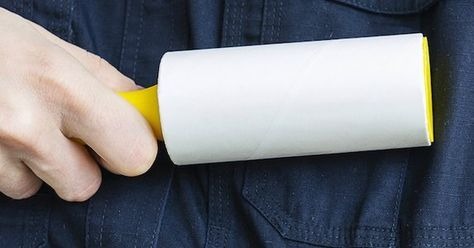
Lint rollers are commonly found at supermarkets and pet stores. These are barrels of adhesive papers mounted on a spindle with a handle. Here’s how to use them to remove lint from clothes:
- Peel the packaging plastic from the roller.
- Roll the paper barrel across the garment. You can roll it sideways or up and down, whatever is most convenient.
- Once the lint roller stops picking up lint, remove the sticky sheet to reveal a fresh one underneath.
Sooner or later, you will run out of adhesive sheets. This means buying replacement sheets or a new lint roller. Since this can have a negative impact on the environment, it’s recommended to choose a reusable lint roller.
It uses a sticky gel to collect the lint. Once the roller gets dirty, you can simply rinse it and use it again. However, in case you don’t want to invest in a lint roller, it’s possible to make one at home.
How to make a lint roller at home?
Things You’ll Need
Tape
Rolling pin
Instructions
1. Stick the tape to one end of the rolling pin.
2. Wrap it around the rolling pin with the sticky side facing you.
3. Cut the tape when you reach the end of the rolling pin. It should stick by itself, but you can also secure it with a small tape piece.
4. Roll it on the clothes to get rid of the lint.
5. Repeat when the tape doesn’t pick up any more lint.
2. Tape to Remove Lint from Clothes
If you’re short on time and only a small area of clothes is affected by lint, you can use tape. There are two methods to use it:
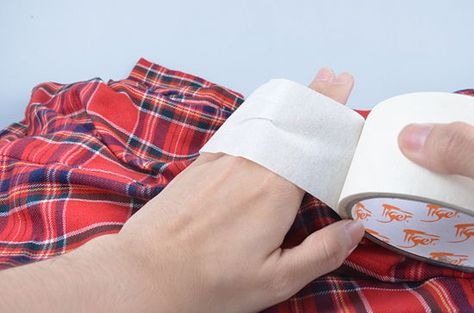
Method 1
- Unroll a tape and wrap it around your hand. Make sure the sticky side is facing away from your fingers.
- Now, pat the clothes gently to pick up the lint.
- Once it gets dirty, flip your hand so that the dirty side faces you and the fresh tape side faces the clothes.
- Continue until all the lint is out.
Method 2
- Cut a wide and long piece of tape.
- Stick it onto the cloth. But make sure the tape is in alignment with the weave of the cloth. Usually, it’s up and down.
- Rub the tape so that it’s smooth.
- Pull it off.
Consider the fabric type before selecting any of these methods. If the fabric is very delicate and valuable, go with method 1. It has a lesser chance of damaging the fibers than method 2.
3. Velcro Strip to Remove Lint from Clothes
A velcro strip is a fastener used on clothes and other textile products. It consists of two thin plastic strips; one has small loops, and the other has small hooks. When closed, the loop side attaches to the hooks.
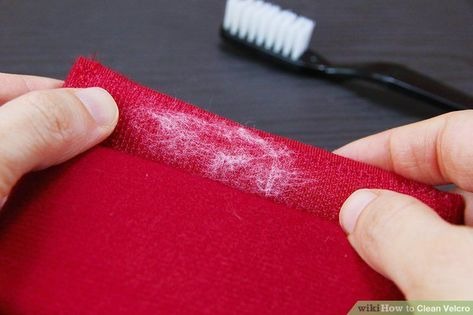
This has an adhesive effect that can be used to secure or even pull off things. So, if you have some old velcro lying around in the house, it’s an excellent option for removing lint from clothes.
- Separate the hook from the loop side.
- Put it against the cloth and drag it downwards.
- Repeat it until all the lint has collected at the bottom of the cloth.
- Pick it up using a lint roller or tape.
4. Rubber Gloves to Remove Lint from Clothes
Rubber gloves are routinely used by pet owners to get rid of the fur and hair clinging to their clothes. Why not use them for lint as well?
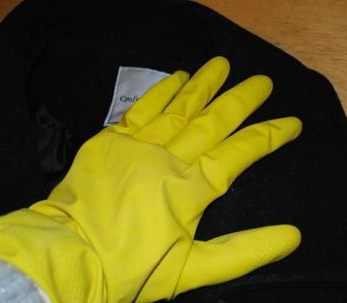
Just wear a pair of rubber gloves and rub them across the fabric. The small bristles on the gloves will collect the lint like a hairbrush collects loose hair. Some of the lint will move down toward the bottom of the cloth.
You can remove it using the same glove, tape, or lint roller. Also, if you don’t have pet hair gloves available, you can also use dishwashing gloves. They are great at picking lint and working on upholstery too.
5. Dryer to Remove Lint from Clothes
The washing machine has excellent features to tackle all of your cloth-related problems. One such feature is the lint screen in the dryer. It is the part of the exhaust system that catches the loose lint from the clothes.
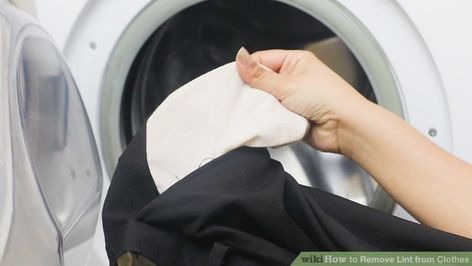
So, it’s always recommended to dry the laundered clothes in the washing machine’s dryer. But if this doesn’t work, there is another helpful feature called the air-only setting on your dryer. Some machines label it as air dry and air fluff.
Put the clothes back in the dryer and turn on the air-only setting. This will circulate unheated air around your garments and cause the lint to come loose.
6. Dryer Sheet to Remove Lint from Clothes
Dryer sheets refer to polyester or cellulose sheets that contain lubricants, softeners, and fragrances. When placed in the laundry, the dryer sheet warms up and releases the ingredients onto your clothes.
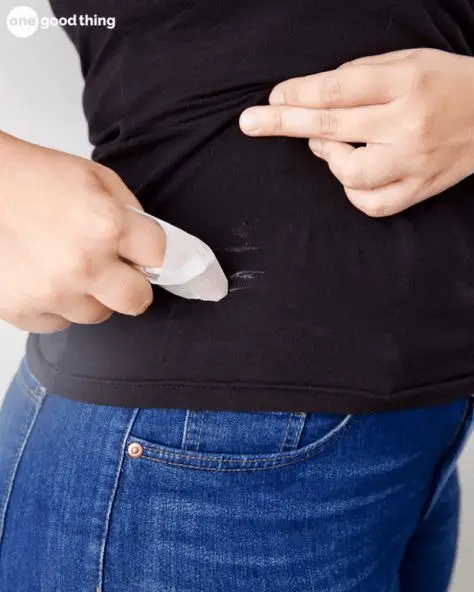
It also reduces static electricity, which contributes to lint formation. So, your clothes come out soft, fresh, and lint-free. However, if your clothes already have lint, you can still use a dryer sheet to get rid of it.
Just grab a dryer sheet and rub it against the cloth. Similar to a lint roller, the dryer sheet will collect all the lint in one place. You can discard the dirty dryer sheet.
7. Cloth Brush to Remove Lint from Clothes
Sometimes, you can’t wash or use adhesives to remove the lint from clothes. It’s because the fabric is either too delicate or too expensive. Exposing it to water or strong adhesives can damage the fibers and create more lint.
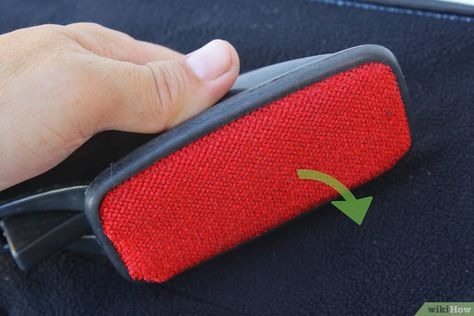
In this case, you should use a cloth brush. It has a long wooden handle with soft bristles made from either horse or boar hair. This makes the bristles natural and light on the fabric. You can find these brushes in any supermarket easily.
To use, simply brush it against the lint-laden fabric. Make sure your strokes are in one direction so that lint collects together. Also, be very gentle to avoid any kind of damage to the fibers. But, if you use the cloth brush on a tougher fabric like wool, you can scrub too.
8. Pumice Stone to Remove Lint from Clothes
Pumice stone is a rock made from water and lava. It has an abrasive surface that works great for exfoliation. Women typically use it to remove dead skin during a shower and achieve a fresh, glowy look.
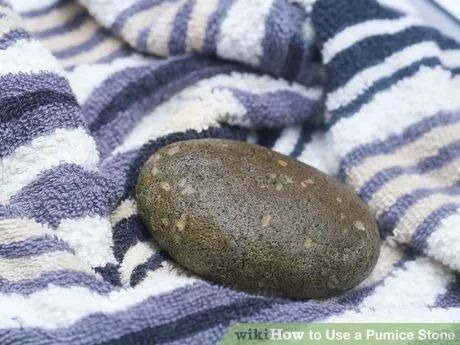
If you have a pumice stone at home, you can also use it to remove lint from wool or fleece clothes. The abrasive rock will catch both small and big lint easily. Just make sure to rub the stone in the direction of the weave.
Going against it will cause the majority of fibers to break and come loose. To avoid that, first, identify where the fabric weave is going and then start rubbing. Also, be gentle in your movements because pumice stone can easily remove the top layer of the cloth.
9. Hair Dryer to Remove Lint from Clothes
If the clothes have a lot of loose lint, an excellent way to get them out is to use a hair dryer. The high air pressure will force the loose lint to break away from the fabric and fly off into the surroundings.
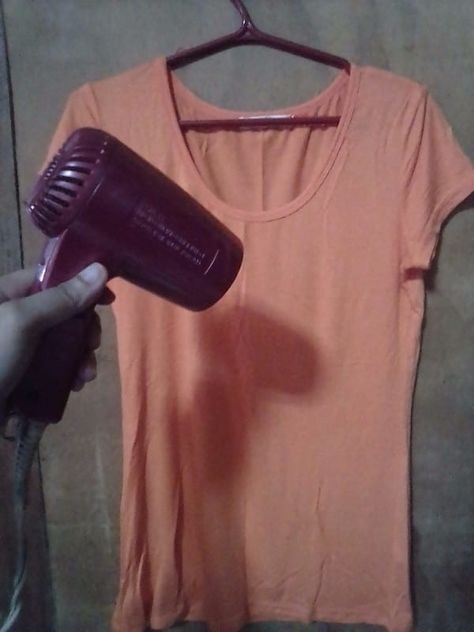
However, there are slight chances of lint still being left behind. You can ensure complete lint removal by hanging the clothes on a hanger. Then, rub them with a cloth brush or pumice stone while blowing air with the hair dryer. This will get the stubborn lint out of your clothes.
10. Razor to Remove Lint from Clothes
Razors are regularly used to remove facial and body hair. But there are several different types for different purposes. For removing lint, you can use two types of razors:
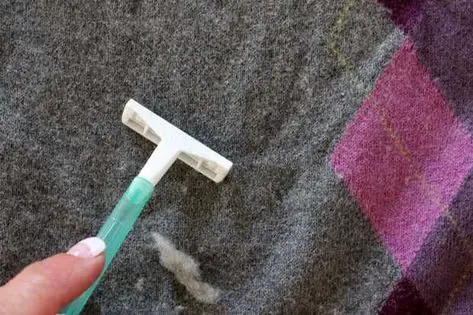
- Single-Blade Razors
As the name suggests, single-blade razors have one blade. It cuts the attached lint neatly from the fabric surface. Since it doesn’t tug at the other fibers, no damage is done.
- Electric Lint Shavers
These are battery-powered shavers designed only to cut and collect the lint. There’s a built-in compartment where all the lint is stored after cutting. You will have to empty it every time it fills up so that the machine’s performance isn’t affected.
You can choose any of these razors depending on your budget and need. Electric lint shavers are typically expensive. So, we don’t recommend them unless you remove lint from your clothes regularly.
Also, when using the razor, it’s best to place the cloth on a flat surface and smooth it out. Put something heavy on the corners of the cloth so that it doesn’t move as you work. The slightest of disturbances can cause the fabric to fold and get cut in the process. Be careful!
11. Sponge or Scouring Pad to Remove Lint from Clothes
Another easy remedy to remove lint from clothes is to use a wet sponge. Just soak in water, squeeze out the excess, and rub the rough side against the fabric. If your sponge doesn’t have a rough side, use a scouring pad instead.
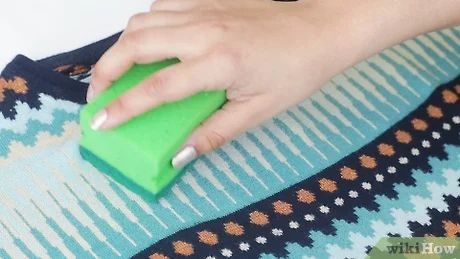
The gentle rubbing will move all the lint on one area of the cloth. You can collect it from there using a tape or lint roller.
12. Wash Without Detergent to Remove Lint from Clothes
When nothing works, try this last method to get rid of lint. Put the clothes back in the washing machine and run a cycle, but don’t add detergent. The purpose is to shake off the loose lint with the pressure of water.
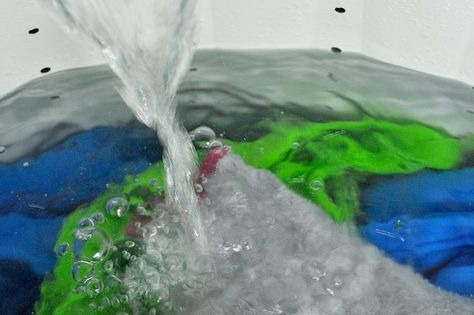
Once the wash cycle is over, take out the clothes and check whether the lint is removed. If not, wash the clothes again and then dry them in an air-only setting. This will ensure all the loose lint is separated from the garments.
How to Prevent Lint on Clothes?
Removing lint from the clothes is not enough. You need to know how to prevent it so that all your clothes stay lint-free in the future. Here are some ways to make that happen:
- Pour ¼-cup of white vinegarinto the wash cycle.
- Wash lint-producing fabrics and clothes with buttons/zippers in a separate load.
- Turn the pockets inside out and clean them before washing.
- Shake the laundered clothes once before drying them.
- Add the dryer sheets to the wash cycle.
- Clean the washing machine, especially if there’s a lint screen.
- If the garment is too delicate or expensive, hand wash it to avoid damage and lint.
Final Thoughts
Lint on clothes can be a nuisance, but it doesn’t have to stay that way. You can always remove lint from clothes using these 12 methods:
- Lint Roller
- Tape
- Velcro Strip
- Rubber Gloves
- Air-Only Setting
- Dryer Sheet
- Cloth Brush
- Pumice Stone
- Hair Dryer
- Razor
- Sponge or Scouring Pad
- Wash Without Detergent
If none of these works, then there is no other way to get out of the problem. You will probably have to change the outfit or turn the garment into cleaning rags. Can you think of some other solution? Let us know in the comments below!